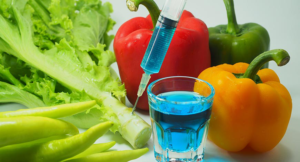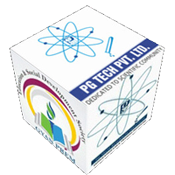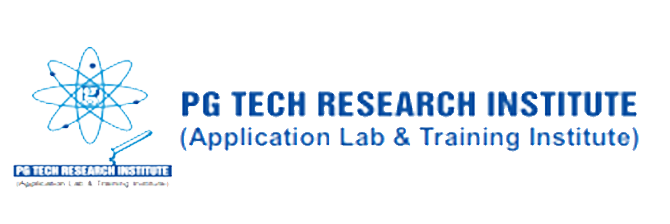Mobile:-+91-731-4993339, 4996222 Mail:-admin@pgtech.in
Research & Publication
HERBAL RESEARCH ACTIVITY
We are actively engaged in the extraction, purification and validation of plant phytochemicals (active constituents) from medicinal plants and their anti-oxidant and Antiproliferative activity of these plant phytochemicals in laboratory. The list of plant phytochemicals are as follows:
- Tannin
- Phenolics
- Flavonoids
- Curcumin
- Phytic acid
- Lectin
- Lycopene
Tannins are the compounds present in the plants which primarily form the basis of pigmentation in the plants. When insects feed on them, they are highly hydroxylated and can form insoluble complexes with carbohydrates and proteins. The phenolic groups of tannins are bound to enzymes and other proteins by hydrogen bonding to amide groups, and form insoluble tannin- protein complexes which are resistant to digestive enzymes of monogastric animals. The presence of tannins adds to astringency of tannin- rich foods (tea and some vegetables and fruits) especially when immature, because of their precipitation due to salivary proteins.
Phytic acid (myo- inositol 1, 2, 3,4,5,6, hexakis-dihydrogen phosphate, IP6) is another factor and is a major storage form of phosphorus in plants (60-90% of total seed phosphorus). It is ubiquitous in seed comprising 1-3% of all nuts, cereals, legumes and oil seeds. It is present as crystals inside protein bodies in discrete regions of seeds, and predominantly in the aleurone layer of wheat and rice. Now a day it is considered as bioneutraceuticals and used in the treatment of various diseases.
Lectins (agglutinins), carbohydrate-binding proteins are also the members of ANFs family, found in a wide variety of plants. Plant lectins are commonly found in food consumed without processing, such as fruit and vegetables. The deleterious effects associated with lectins are food poisoning, vomiting, bloating, and diarrhea in humans. However, recent finding considers lectin as one of the lead molecules in pharmaceutical industry such as antifungal, antiproliferative and HIV-1 reverse-transcriptase activities.
Polyphenols and flavonoids are a diverse class of compounds which occur naturally in a wide range of plants. More than 8,000 polyphenolic compounds have been identified in various plant species. All plant phenolics compounds arise from a common intermediate, phenylalanine, or a close precursor, shikimic acid. Primarily they occur in conjugated forms, with one or more sugar residues linked to hydroxyl groups, although direct linkages of the sugar (polysaccharide or monosaccharide) to an aromatic carbon also exist. Association with other compounds, like carboxylic and organic acids, amines, lipids and linkage with other phenol is also common. They are mainly considered as anti-oxidant and anti-proliferative mechanism.
Lycopene is a carotenoid − a natural pigment that gives red color to the some fruits and vegetables. It is recognized as the protective effects against prostate cancer and cardiovascular disease. It also contains much anti-oxidant activity and are used as a health benefits.
Research Wing
PG Tech Research Institute
COMPARATIVE STUDIES OF ORGANIC INORGANIC AND NORMAL GROWTH OF OCIMUM TTANUIFLORUM AND OCIMUM GRASTISSIUMUM BY EXTRACTION OF UV AND HPLC.
Abstract
The foliage of Tulsi has a strong smell,green or purple in color and taste similar to clove. It grows wild in the tropics and warm regions. It has great value in the Hindu culture. Tulsi has great potential owing to its valuable Cosmetic properties.Its essence is used in various forms like face-washes, power, pulp,herbal soap, oil etc. In ayurveda , Tulsi is known as ‘’Queen of Herbs’’.The top fifteen medicinal uses of Tulsi are as follows: Healing Power, Fever and common cold,Coughs, Respiratory Disorder, Kideny Stone, Stress, Mouth Infections, Insect Bites, Teeth Disorder, Headaches, Eye Disorders.
The experimenral material consist of two species: Ocimum Gratissimum’(Ram tulsi) and Ocimum tenuiflorum’(Krishna tulsi) plant which are grown in three composition organic, Inorganic,and in Normal fertilizer.
These plants are grown in varios fertilizer:-
Organic fertilizer :- Urea,Cow -dung, Humic acid
Inorganic fertilizer:-Na,P,K
Normal Fertilizer :- Black Soil.
Chemical Reagent used Ethylene Diamine tetra acetate(EDTA)
Amit Upadhyay
PG Tech Research Institute
SYNTHESIS, CHARACTERIZATION AND ANTIBACTERIAL ACTIVITY OF N SULPHONAMIDE DRUG AND ANALOGUE OF SULPHONAMIDE DRUG
Abstract
The science dealing with the study of prevention and treatment of diseases caused by micro-organisms is known as medical microbiology. The different disciplines of microbiology are studied under following heads,as follows: virology (study of viruses), Bacteriology(study of bacteria),mycology(study of fungi) phycology (study of algae) and protozoology (study of protozoa) .To kill these organism different types of chemicals are used and these chemicals agents are called the antimicrobial agents.
In this research we are focusing on the executed plan of work which invoilves proper selection of drugs, theire synthesis and characterization, selection and optimization of suitable reactions for the synthesis of mutual drugs, characterization of the synthesized products, and in vitro studies of the synthesized drugs. Each of these areas is studied in detail for the fruitful research outcome.
The objective taken in this research are as follows:
- Synthesis of structurally analogue of sulphonamide drug.
- Comparative study of drugs with sulphonamides using Fourier transform infrared spectroscopy(FTIR)
- Comparative study of synthesized drug as antibactetial with reference to the sulphonamide drugs.
- In future, the research of more antibacterial drugs with their effect and more active against bacteria.
Poornima Paliwal
PG Tech Research Institute
FORMULATION AND CHARECTRISTIC OF BILAYER TABLET OF ANTIRETROVIRAL DRUG(ABACAVIR/LAMIVUDINE)
Abstract
HIV, the causative agent of AIDS, is a single-stranded RNA that belong to the family of Retroviridae. Its genetic information is not encoded as DNA, but as RNA and therefore is reserve-transcribed into DNA. HIV is round partical with a size of between 100-120nm in diameter and it is surround by a lipid bilayer. It has half-life of less than 2 hours.
Tablet may be defined as solid pharmaceutical dosage forms containing drug substance with or without suitable diluents and prepared either by compression or molding methods.The tablet must be sufficiently strong and resistance to shock and abrasion and to without handling, during manufacturing, packing, shipping, and use. Hardness and friability tests measure this property.
Plan of Work
- Review of Literature.
- Preformulation study of drugs and excipients.
- Precompretion parameter
- Drug excipient compatibility study
- Macroscopic properties
- Microscopic properties
- IR Spactroscopy
- Preparation of stable API-1,API-2 bilayer tablet.
- Optimization of concentration of excipients and method of manufacturing
- Evaluation of physical parameter
- Like thickness
- Hardness
- Friability and
- Disintegration Time of tablets.
- Evaluation of In-vitro drug release of the tablets
- Selection of best formulation on the basis of In vitro drug release
Durga Patel
PG Tech Research Institute
Development and characterization of effective topical nanogel for corneal fungal infection
Abstract
Fungal infection of the eye are less common than infections with bacteria or viruses, but are usually severe and may lead to loss of vision.Infections may involve the cornea(Keratitis), the interior of the eye(endophthalmitis), or orbit, and may occur following trauma or systemic disseminated infection.According to the World Health Organization,corneal diseases are a major cause of vision loss and blindness.The term fungal keratitis refers to a corneal infection caused by fungi. One type of fungus that can infect the cornea is Fusarium. When Fusarium infects the cornea, the eye disease is referred to as Fusarium keratitis.
Neha Jha
PG Tech Research Institute
ANTIMICROBIAL ACTIVITY OF SOME SELECTED POISONOUS PLANT IN INDORE
Abstract
Poison a substance that, on ingestion, inhalation, absorption, application, injection, or development within the body, in relatively small amount, may cause structural damage or functional disturbance or A substance that ,when introduced into or absorbed by a living organism, causes death or injury.They are a different group from plant which cause illness if eaten in very large amount or have physical qualities that cause illness,e.g.clover in bloat, tree loppings in omasal impaction.The magnitude of animal losses to ingestion of poisonous plant .Losses include not only those due to mortality but also those due to poor productivity such as decreased weight gain or decreased milk or egg production.
Nitu Singh
PG Tech Research Institute
PHENOLIC COMPOUNDS CHARACTERIZATION AND BIOLOGYCAL ACTIVITIES OF CITRUS AURANTIUM BLOOM
Abstract
Citrus plants are known to possess beneficial activities for human health. In addition, ethnopharmacological application of plants is a good tool to explore their bioactivities and active compounds. This research was carried out to evaluate the phenolic and flavonoid analysis, antioxidant properties, anti cancer activities of Citrus aurantium bloom. The total phenolics and flavonoids compared to ethanolic and boiling waters extracts. The total obtained total phenolic values for methanolic Citrus aurantium bloom extracts was 4.55+_ 0.05mg gallic acid equivalent (GAE)/g dry weight (DW) and for total flavonoids it was 3.83 +_ 0.05 mg rutin equivalent/g DW. In addition, the RP-HPLC of phenolics and flavonoids indicated the presence of gallic acid,pyrogallol,syringic acid ,caffein acid rutien ,quercetin and naringin as bioactive compounds. The antioxidant activities of citrus aurantium bloom were examined by the 1,1-diphenyl1-2 picryl-hydrazyl(DPPH) assay and the ferric reducing/ antioxidant potential(FRAP). The free radical scavenging and ferric reducing power activities were higher for the methanolic extract of citrus aurantium bloom at a concentration of 300 ug/ml,with value of 55.3% and 51.7%,respectively , as compared to the corresponding boiling water and ethanolic , but the activities were lower than those of antioxidant standards such as BHT and α-tocopherol. Further more, the anti-inflammatory result of methanolic extract showed appreciable reduction in nitric oxide production of stimulated RAW 264.7 cell at the presence of plant extract. Apart form that the anticancer activity of the methanolic extract was investigated in vitro against human cancer cell lines (MCF-7;MDA-MB-231),human colon adenocarcinoma (HT-29) and change cell as a normal human hepatocyte. The obtained result demonstrated the moderate to appreciable activities against all cell line tested and the compound present in the extract are non-toxic which make them suitable as potential therapeutics. Shabaz Khan
Coordination with PGTRI
COMPARATIVE STUDY ON METHOD DEVELOPMENT AND VALIDATION OF LAMOTRIGINE IN TABLE DOSAGE FORM
Abstract
A simple, rapid and precise method was developed for the quantitative determination of Lamotrigine in tablet dosage from. The method was based on RP-HPLC. Chromatographic separation was performed on a fortis C18 (150mm X4.6mm and equivalent 5μm) column using a mobile phase of acetonitrile (ACN) and phosphate buffer (0.05mol) ratio 20:80 at pH 2.5 adjusted with dilute orthophosphoric acid. The following system conditions were maintained throughout development and validation i.e., flow rate of mobile phase 1ml/min, column temperature at 40˚C and the detecting of drug by a UV-wave length at 270 nm. The Lamotrigine was well resolved on the stationary phase and the retention time was 5.1 minute. The method was validated the drug was shown to be linear for drug in 10-30 μg /ml. the correlation coefficient (r2) for the drug was 0.998. The Precision, Accuracy, LOD and LOQ were determined to validate the method.
PREPARATION AND EVALUATION OF BILAYER TABLET OF FUROSIMIDE.
Abstract
For the purpose of enhancement the bioavailability of furosemide (FR), a floating dosage from with controlled release of FR was designed in this study.Because of the lower solubility of active material in the gastric medium , it was first enhanced by preparing an inclusion complex of FR with beta-cyclodextrin in a 1:1 proportion using the kneading method. Following the design of dosage from, bilayer floating tablets were prepared. After dissolution rate studies were performed using the continuous flow-through cell method, the formulation that provided delivery of active material near the target profile was given to six health male volunteer subjects,and in vivo tests were performed. Bilayered drugs delivery system is well known modified release dosage from may offer one or more advantages over immediate release formulations of the same drug.Also the formulation is much eaiser than the other controlled drugs delivery systems.The major aim of controlled drug delivery is to reduce the frequency of dosing.
Done By
Mr.Ramakant Sharma
from Satya Sai College of Pharmacy Indore
Co-ordination with PG Tech Research Institute
FORMULATION AND EVALUATION OF LIPOSOMES OF LAMIVUDINE
Abstract
Human Immunodeficiency Virus (HIV) Infection And Acquired Immune Deficiency Syndrome(AIDS) Commonly Referred To As HIV & AIDS Have Emerged As Being Amongst The Serious And Challenging Public Health Problems In the World.
Liposome are bilayer vesicles which have found use, among other applications, as drugs delivery vehicles.Conventional techniques for liposome preparation and size reduction remain popular as these are simple to implement and do not require sophisticathed equipment.However,issues related to scale-up for industrial production and scale-down for point-of-care applications have motivated improvements to conventional processes and have also led to the development of novel routes to liposome formation. In this article,these modified and new method for liposome preparation have been reviewed and classified with the objective of updating the reader to recent development in liposome production technology.
Synonyms:
4-amino-1-[(2R,5S)-2(hydroxymethyl)-1,3-oxathiolan-5-yl]-1,2-dihydropyrimidin-2-one

Prepared by
Ms Madhuri Meghwanshi
Under PG Tech Research Institute
ADVANCE FOOD ANALYSIS AND QUALITY CONTROL
Abstract
For a health body, a balanced diet is required which is obtained from good nutrition through food products. These days, many people malpractice the adulteration of food products to gain profit in an illegal ways and earn money by deceiving the consumers. But, the adulteration of food is an emerging problem of concern which affects human health directly. There are a bundle of food adulterants which pose harmful effects to human, hence it is necessary for mankind to overcome this malpractice. In the present review , we will discuss about some of the food adulteterants causing serious health concerns to human beings.

Anjali Gupta
From Career College Bhopal
Coordination with
PG Tech Research Institute
DEVELOPMENT AND EVALUATION OF TOPICAL GEL OF VALTRX (VALACYCLOVIR) DRUG
Abstract
Topical gels of valdecoxib topical gel prepared using different gelling agents(Viz,carbopol, HPMC , Sodium alginate, sodium CMC). Formulation were evaluated for pH, reheological behavior, drugs content and in vitro drug diffusion. Selected formulations of all the gelling agents appeared to be non-Newtonian and pseudo plastic behavior. Drug content was high(>98%) in gels.Drug release from the carbopol gels increased with the increase in the concentration of 20%. The drugs release increased with the increase in concentration of ethanol. In case of gels containing HPMC, sodium alginate, sodium CMC as gelling agents ,addition of PG up to 5%, increased the release of drug from the gels. However, release decreased with increase in the concentration of PG up to 10%. In case of HPMC GELS,ADDITION OF ETHANIL DECREASED THE RELEASE OF Valdecoxib from the gels. It is concluded that PG is a good penetration enhancer and carbopol good gelling agents for Valdecoxib gels.
Prepared By
Ms Aprana Joshi
under PG Tech Research Institute

